Cooling Water Sufficiency in a Warming World: Projection Using an Integrated Assessment Model and a Global Hydrological Model
Abstract
1. Introduction
2. Materials and Methods
2.1. Model
2.2. Data
2.3. Simulation and Analyses
3. Results and Discussion
3.1. Water Requirement
3.1.1. Continental Perspective
3.1.2. Local Perspective
3.2. Water Availability
3.2.1. Continental Perspective
3.2.2. Local Perspective
3.3. Cooling Water Sufficiency
3.4. Uncertainties and Limitations
4. Conclusions
Author Contributions
Acknowledgments
Conflicts of Interest
References
- King, C.W.; Holman, A.S.; Webber, M.E. Thirst for energy. Nat. Geosci. 2008, 1, 283. [Google Scholar] [CrossRef]
- Boogert, A.; Dupont, D. The nature of supply side effects on electricity prices: The impact of water temperature. Econ. Lett. 2005, 88, 121–125. [Google Scholar] [CrossRef]
- Schaeffer, R.; Szklo, A.S.; Pereira de Lucena, A.F.; Moreira Cesar Borba, B.S.; Pupo Nogueira, L.P.; Fleming, F.P.; Troccoli, A.; Harrison, M.; Boulahya, M.S. Energy sector vulnerability to climate change: A review. Energy 2012, 38, 1–12. [Google Scholar] [CrossRef]
- Van Vliet, M.T.H.; Yearsley, J.R.; Ludwig, F.; Vogele, S.; Lettenmaier, D.P.; Kabat, P. Vulnerability of us and european electricity supply to climate change. Nat. Clim. Change 2012, 2, 676–681. [Google Scholar] [CrossRef]
- Van Vliet, M.T.H.; Wiberg, D.; Leduc, S.; Riahi, K. Power-generation system vulnerability and adaptation to changes in climate and water resources. Nat. Clim. Change 2016, 6, 375–380. [Google Scholar] [CrossRef]
- Bartos, M.D.; Chester, M.V. Impacts of climate change on electric power supply in the western United States. Nat. Clim. Change 2015, 5, 748. [Google Scholar] [CrossRef]
- Miara, A.; Macknick, J.E.; Vörösmarty, C.J.; Tidwell, V.C.; Newmark, R.; Fekete, B. Climate and water resource change impacts and adaptation potential for us power supply. Nat. Clim. Change 2017, 7, 793. [Google Scholar] [CrossRef]
- Koch, H.; Vögele, S. Dynamic modelling of water demand, water availability and adaptation strategies for power plants to global change. Ecol. Econ. 2009, 68, 2031–2039. [Google Scholar] [CrossRef]
- Förster, H.; Lilliestam, J. Modeling thermoelectric power generation in view of climate change. Reg. Environ. Change 2010, 10, 327–338. [Google Scholar] [CrossRef]
- Koch, H.; Vögele, S.; Kaltofen, M.; Grünewald, U. Trends in water demand and water availability for power plants—Scenario analyses for the german capital berlin. Clim. Change 2012, 110, 879–899. [Google Scholar] [CrossRef]
- Feeley, T.J.; Skone, T.J.; Stiegel, G.J.; McNemar, A.; Nemeth, M.; Schimmoller, B.; Murphy, J.T.; Manfredo, L. Water: A critical resource in the thermoelectric power industry. Energy 2008, 33, 1–11. [Google Scholar] [CrossRef]
- Chandel, M.K.; Pratson, L.F.; Jackson, R.B. The potential impacts of climate-change policy on freshwater use in thermoelectric power generation. Energy Policy 2011, 39, 6234–6242. [Google Scholar] [CrossRef]
- Clemmer, S.; Rogers, J.; Sattler, S.; Macknick, J.; Mai, T. Modeling low-carbon us electricity futures to explore impacts on national and regional water use. Environ. Res. Lett. 2013, 8, 015004. [Google Scholar] [CrossRef]
- Macknick, J.; Sattler, S.; Averyt, K.; Clemmer, S.; Rogers, J. The water implications of generating electricity: Water use across the United States based on different electricity pathways through 2050. Environ. Res. Lett. 2012, 7, 045803. [Google Scholar] [CrossRef]
- Kyle, P.; Davies, E.G.R.; Dooley, J.J.; Smith, S.J.; Clarke, L.E.; Edmonds, J.A.; Hejazi, M. Influence of climate change mitigation technology on global demands of water for electricity generation. Int. J. Greenh. Gas Control 2013, 13, 112–123. [Google Scholar] [CrossRef]
- Fricko, O.; Parkinson, S.C.; Johnson, N.; Strubegger, M.; van Vliet, M.T.H.; Riahi, K. Energy sector water use implications of a 2 °C climate policy. Environ. Res. Lett. 2016, 11, 034011. [Google Scholar] [CrossRef]
- Fujimori, S.; Hasegawa, T.; Masui, T.; Takahashi, K.; Herran, D.S.; Dai, H.; Hijioka, Y.; Kainuma, M. Ssp3: Aim implementation of shared socioeconomic pathways. Global Environ. Change 2017, 42, 268–283. [Google Scholar] [CrossRef]
- Hanasaki, N.; Kanae, S.; Oki, T.; Masuda, K.; Motoya, K.; Shirakawa, N.; Shen, Y.; Tanaka, K. An integrated model for the assessment of global water resources—Part 1: Model description and input meteorological forcing. Hydrol. Earth Syst. Sci. 2008, 12, 1007–1025. [Google Scholar] [CrossRef]
- Hanasaki, N.; Kanae, S.; Oki, T.; Masuda, K.; Motoya, K.; Shirakawa, N.; Shen, Y.; Tanaka, K. An integrated model for the assessment of global water resources—Part 2: Applications and assessments. Hydrol. Earth Syst. Sci. 2008, 12, 1027–1037. [Google Scholar] [CrossRef]
- Hanasaki, N.; Fujimori, S.; Yamamoto, T.; Yoshikawa, S.; Masaki, Y.; Hijioka, Y.; Kainuma, M.; Kanamori, Y.; Masui, T.; Takahashi, K.; et al. A global water scarcity assessment under shared socio-economic pathways—Part 1: Water use. Hydrol. Earth Syst. Sci. 2013, 17, 2375–2391. [Google Scholar] [CrossRef]
- Fujimori, S.; Hanasaki, N.; Masui, T. Projections of industrial water withdrawal under shared socioeconomic pathways and climate mitigation scenarios. Sustain. Sci. 2017, 12, 275–292. [Google Scholar] [CrossRef]
- Fujimori, S.; Tu, T.T.; Masui, T.; Matsuoka, Y. Aim/Cge [Basic] Manual; Center for Social and Environmental Systems Research, National Institute for Environmental Studies: Tsukuba, Japan, 2012; p. 74. [Google Scholar]
- Ando, N.; Yoshikawa, S.; Fujimori, S.; Kanae, S. Long-term projections of global water use for electricity generation under the shared socioeconomic pathways and climate mitigation scenarios. Hydrol. Earth Syst. Sci. Discuss. 2017, 2017, 1–25. [Google Scholar] [CrossRef]
- Van Vuuren, D.P.; Riahi, K.; Calvin, K.; Dellink, R.; Emmerling, J.; Fujimori, S.; Kc, S.; Kriegler, E.; O’Neill, B. The shared socio-economic pathways: Trajectories for human development and global environmental change. Global Environ. Change 2017, 42, 148–152. [Google Scholar] [CrossRef]
- Center for International Earth Science Information Network (CIESIN) Columbia University; Centro Internacional de Agricultura Tropical (CIAT). Gridded Population of the World Version 3 (Gpwv3): Population Grids; Socioeconomic Data and Applications Center (SEDAC) Columbia University: Palisades, NY, 2005. [Google Scholar]
- S & P Platts. World Electric Power Plants Database. Available online: https://www.platts.com/products/world-electric-power-plants-database (accessed on 30 June 2018).
- CARMA (Carbon Monitoring for Action). Power Plants. Available online: http://carma.org/ (accessed on 30 June 2018).
- Hempel, S.; Frieler, K.; Warszawski, L.; Schewe, J.; Piontek, F. A trend-preserving bias correction—The isi-mip approach. Earth Syst. Dynam. 2013, 4, 219–236. [Google Scholar] [CrossRef]
- Hanasaki, N.; Fujimori, S.; Yamamoto, T.; Yoshikawa, S.; Masaki, Y.; Hijioka, Y.; Kainuma, M.; Kanamori, Y.; Masui, T.; Takahashi, K.; et al. A global water scarcity assessment under shared socio-economic pathways—Part 2: Water availability and scarcity. Hydrol. Earth Syst. Sci. 2013, 17, 2393–2413. [Google Scholar] [CrossRef]
- Macknick, J.; Newmark, R.; Heath, G.; Hallett, K.C. Operational water consumption and withdrawal factors for electricity generating technologies: A review of existing literature. Environ. Res. Lett. 2012, 7, 045802. [Google Scholar] [CrossRef]
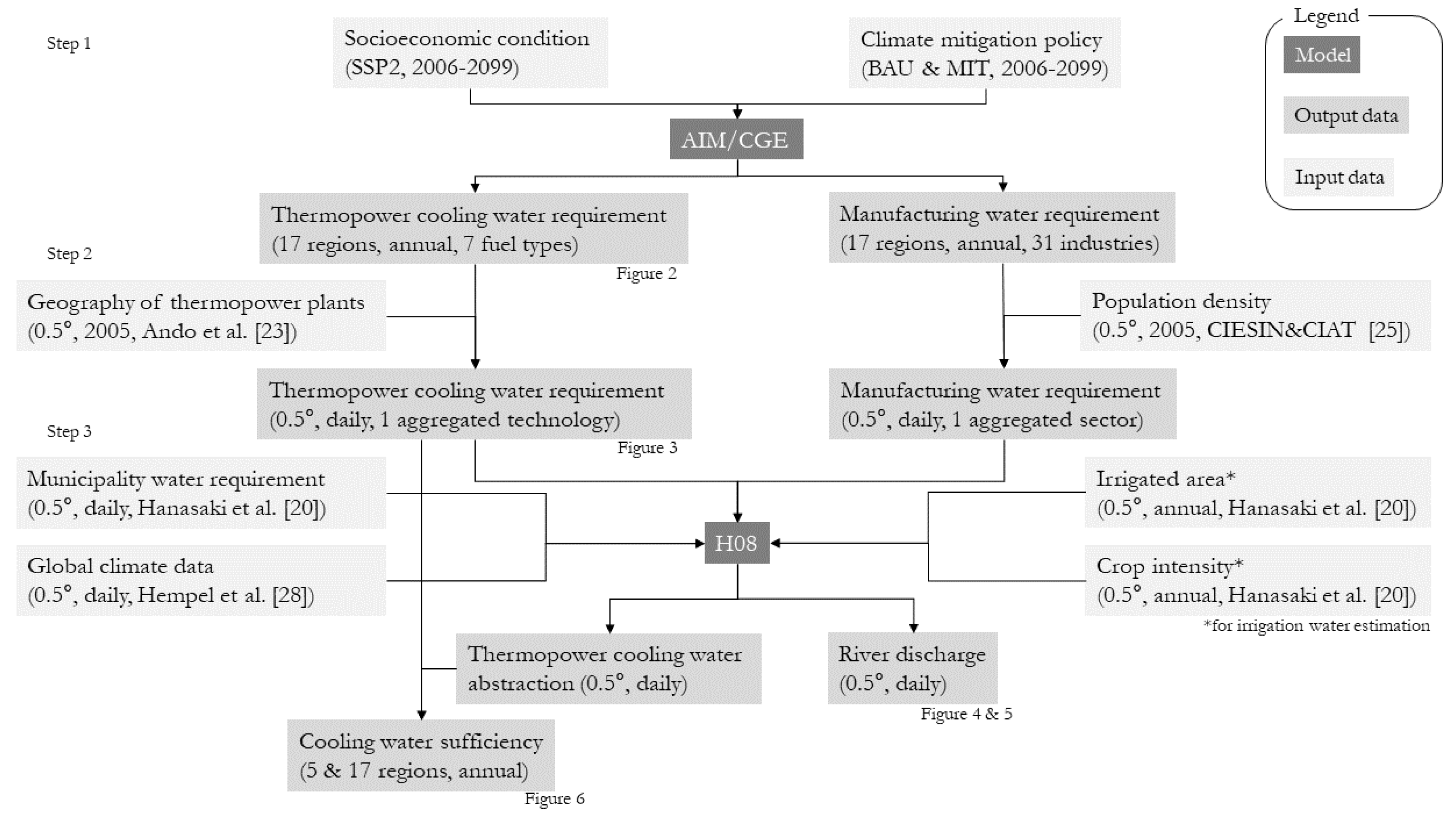
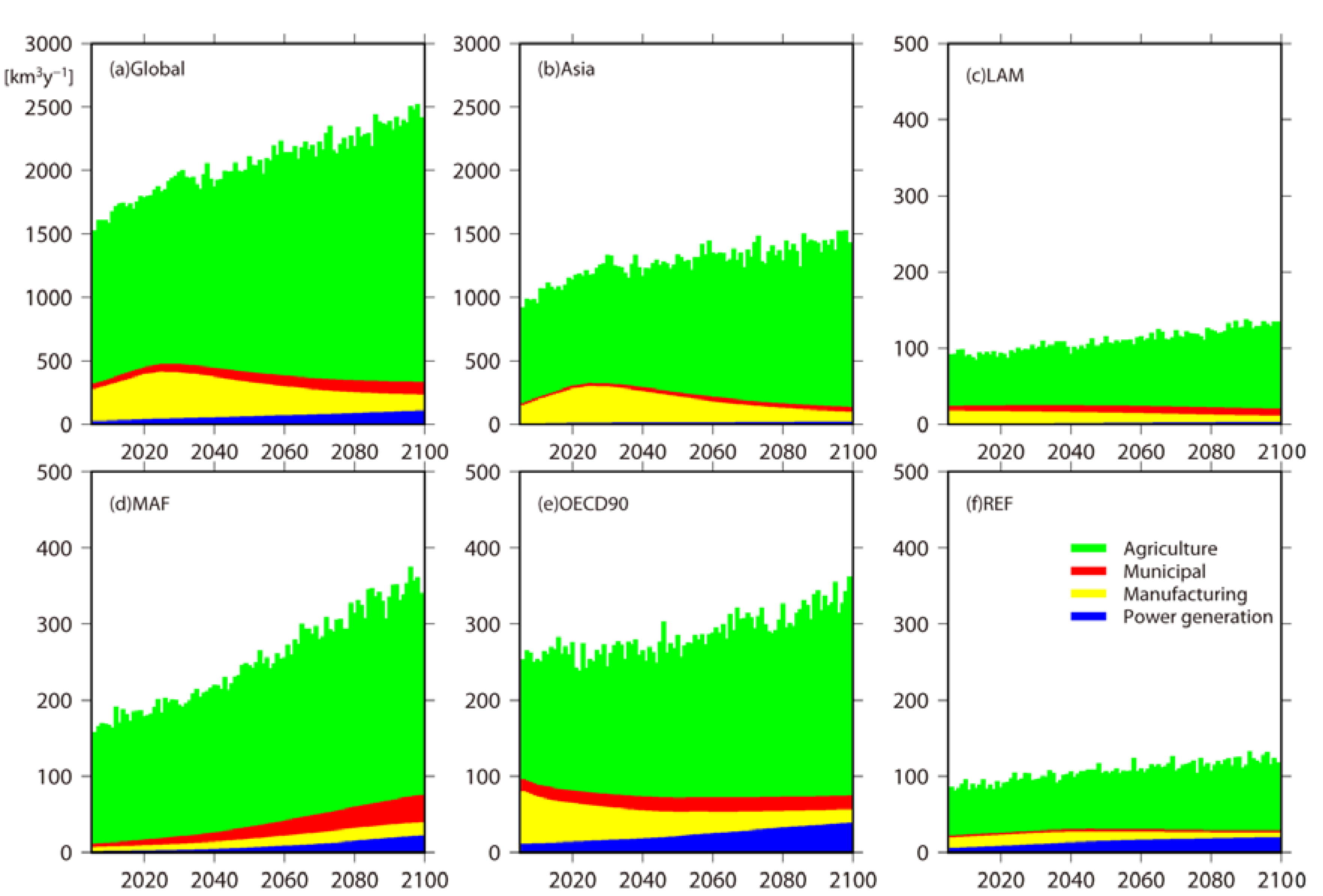
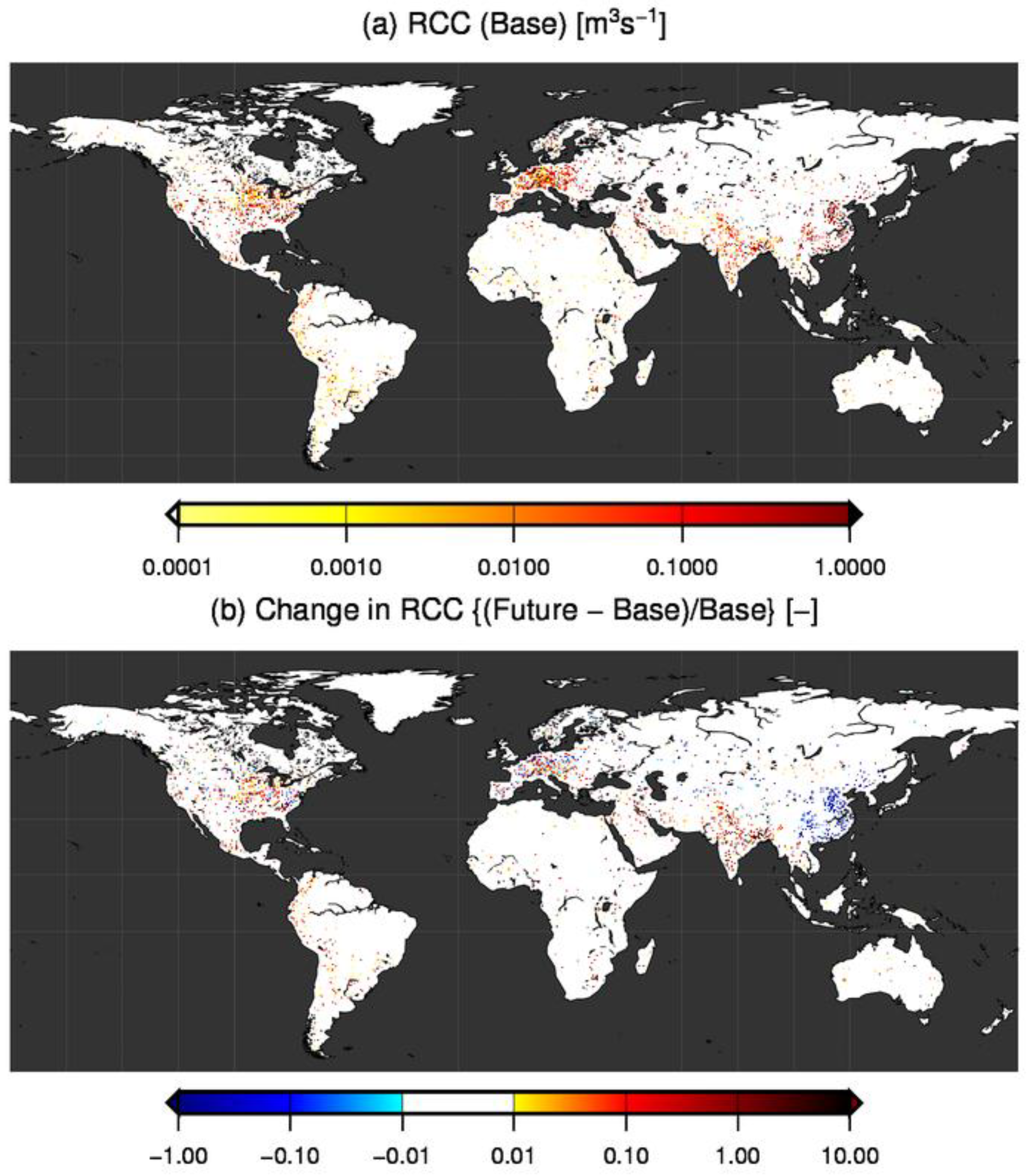
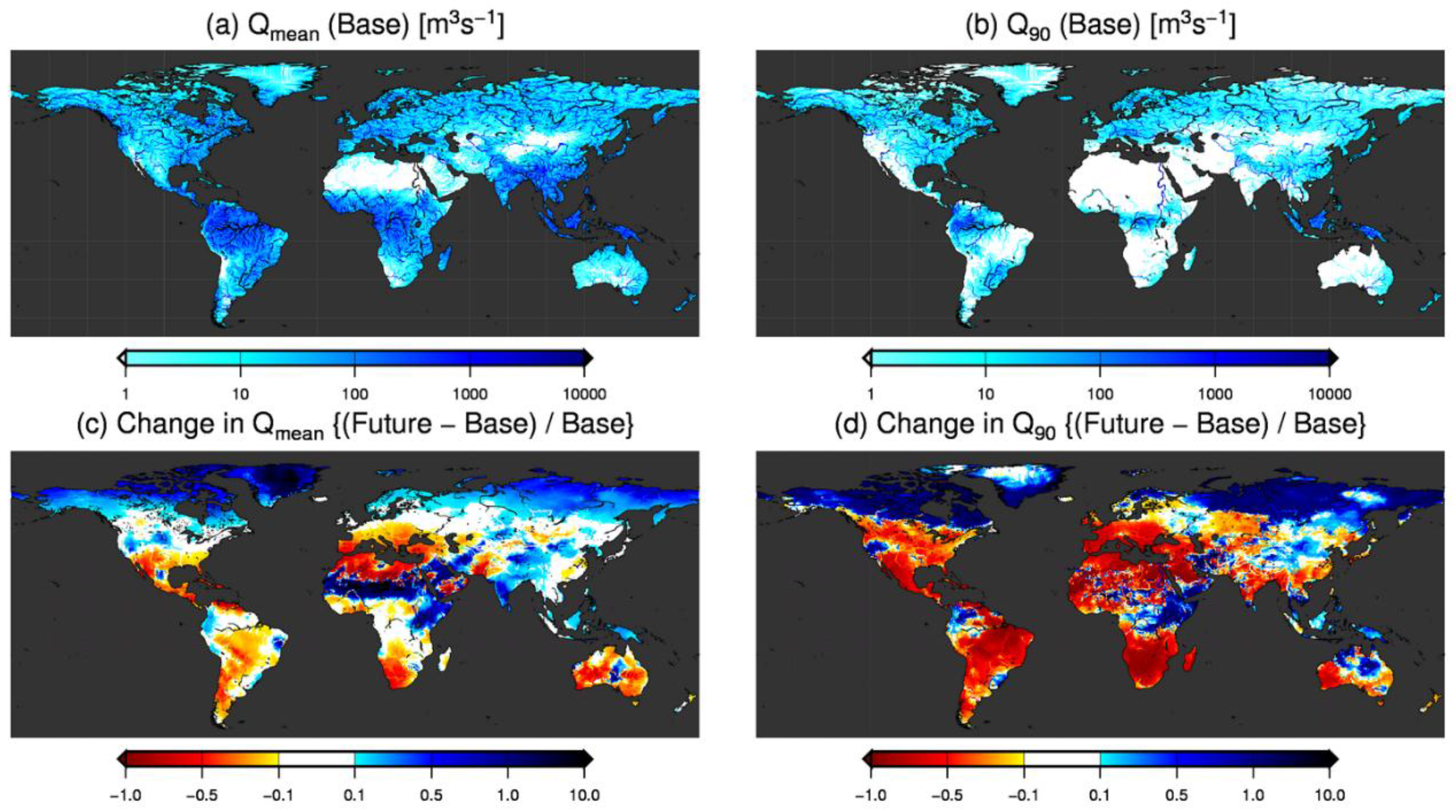
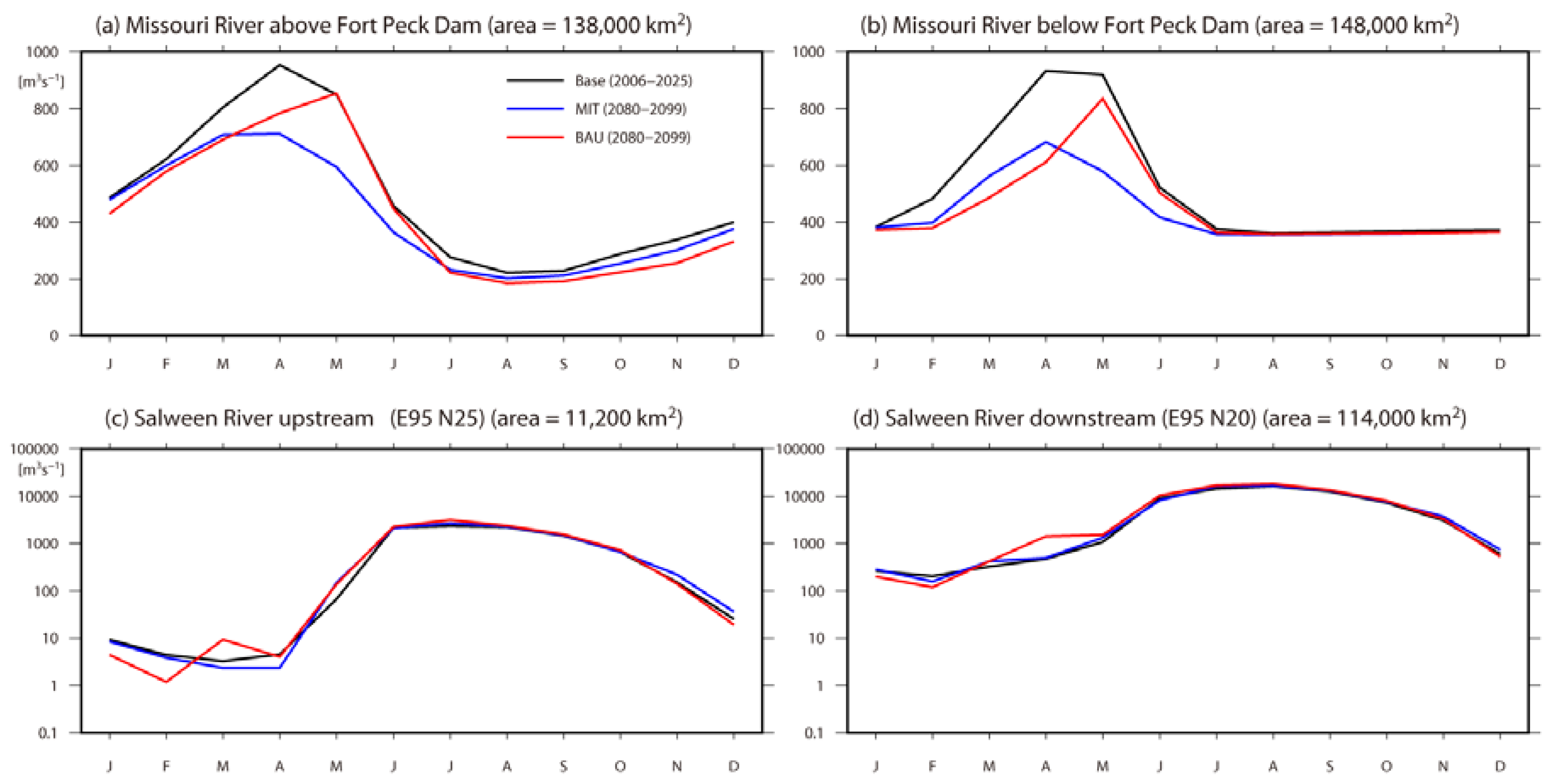
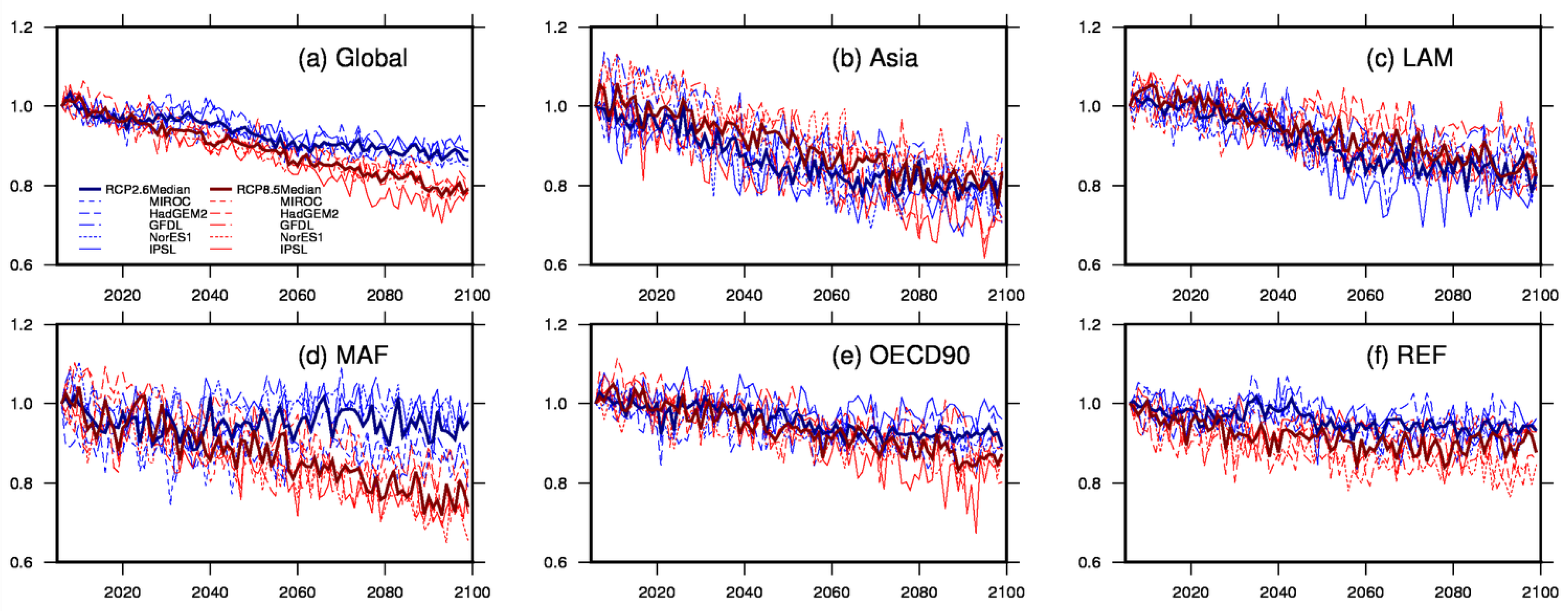
| Van Vliet et al. [4] | Van Vliet et al. [5] | Bartos and Chester [6] | Miara et al. [7] | This study | |
|---|---|---|---|---|---|
| Domain | US and EU | Global | Western US | US | Global |
| Spatial resolution | 0.5 | 0.5 | 0.125 | 0.05 | 0.5 |
| Time | 2040s (2031–2060) | 2050s (2040–2069) | 2050s (2040–2060) | 2050s (2035–2064) | 2050s (2040–2069) |
| Scenarios | SRES B1 & A2 | RCP 2.6 & 8.5 | SRES B1, A1, A2 | RCP 8.5 | RCP2.6 & 8.5 |
| Constraints | Streamflow, stream temperature | Streamflow, stream temperature | Streamflow, stream temperature, air temperature, humidity | Streamflow, stream temperature, air temperature, humidity | Streamflow |
| CWS calculation | For 96 individual plants | For 1427* individual plants | For 978 individual plants | For 1080 individual plants | At grid cells |
| Cooling water requirement | Fixed at present | Fixed at present, five adaptation options | Fixed at present | Fixed at present | Demand growth according to SSP2 |
| Water abstraction of other sectors | No | No | No | No | Irrigation, manufacturing, municipal |
| Reduction in CWS | 4.4–16% (US) 6.3–19% (EU) | 7.0–12% (global, 2050s) | 1.4–3.5% (western US) | 2.4 % (US) | 7.9–11.4% (global) 4.8–9.0 (US) 1.5–3.1 (EU) |
| Note | *28% of thermoelectric power installed capacity worldwide | Reduction in CWS under a 10-year drought: 7.4–9.5% (western US) |
© 2018 by the authors. Licensee MDPI, Basel, Switzerland. This article is an open access article distributed under the terms and conditions of the Creative Commons Attribution (CC BY) license (http://creativecommons.org/licenses/by/4.0/).
Share and Cite
Zhou, Q.; Hanasaki, N.; Fujimori, S.; Yoshikawa, S.; Kanae, S.; Okadera, T. Cooling Water Sufficiency in a Warming World: Projection Using an Integrated Assessment Model and a Global Hydrological Model. Water 2018, 10, 872. https://doi.org/10.3390/w10070872
Zhou Q, Hanasaki N, Fujimori S, Yoshikawa S, Kanae S, Okadera T. Cooling Water Sufficiency in a Warming World: Projection Using an Integrated Assessment Model and a Global Hydrological Model. Water. 2018; 10(7):872. https://doi.org/10.3390/w10070872
Chicago/Turabian StyleZhou, Qian, Naota Hanasaki, Shinichiro Fujimori, Sayaka Yoshikawa, Shinjiro Kanae, and Tomohiro Okadera. 2018. "Cooling Water Sufficiency in a Warming World: Projection Using an Integrated Assessment Model and a Global Hydrological Model" Water 10, no. 7: 872. https://doi.org/10.3390/w10070872
APA StyleZhou, Q., Hanasaki, N., Fujimori, S., Yoshikawa, S., Kanae, S., & Okadera, T. (2018). Cooling Water Sufficiency in a Warming World: Projection Using an Integrated Assessment Model and a Global Hydrological Model. Water, 10(7), 872. https://doi.org/10.3390/w10070872





